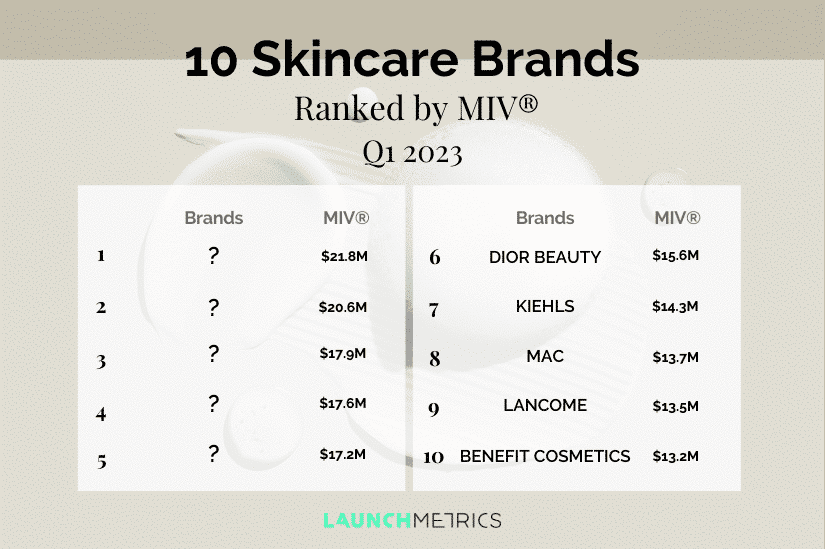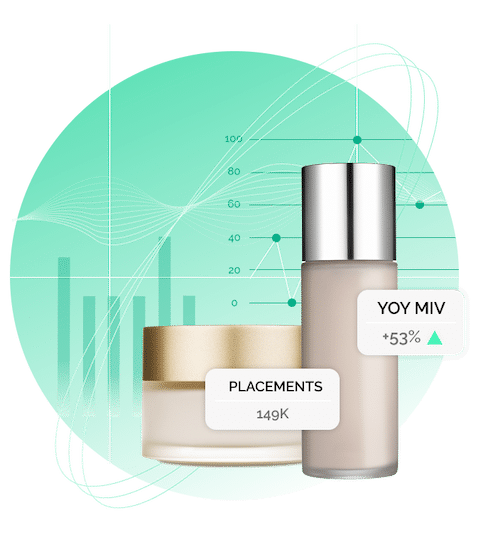Welcome to our dynamic beauty insights capsule series, where we uncover the transformative potential of beauty categorization. In this second installment, we delve into the captivating world of skincare. After this post, we’ll have one last, but not least, exciting blog coming up dedicated to haircare. Additionally, if you missed it, our first blog explored Why Makeup Dominated the Beauty Subcategory Scene in Q1 2023.
This beauty insights blog is your essential guide to understanding how strategic categorization can profoundly impact your brand’s performance. Are you launching new products? Or maybe, you’re aiming to boost your brand’s visibility? Either way, harnessing the power of beauty categorization is the key to unlocking remarkable growth opportunities.
In this article you’ll learn…
Skincare Product Categorization
Skincare emerges as a dominant force in Q1 2023, following closely behind the makeup category. The reasons behind this phenomenon are quite straightforward. In the wake of the post-pandemic era, this $430B USD beauty industry has undergone substantial transformations. Amidst these changes, skincare stands out as a remarkably resilient segment, showcasing its unwavering strength within the industry.
It takes more effort than ever before to promote the latest skincare products, brand loyalty alone is no longer sufficient. Relevance and impact within the skincare category’s ever-evolving landscape are crucial factors to consider. So, strategic planning has never been more critical.
Driven by a focus on health and preventative measures in the wake of COVID-19, companies across consumer goods industries have swiftly adapted. They have aligned their traditional portfolios to align with emerging health needs. The US National Center for Biotechnology Information revealed that 46% of consumers integrated a facial skincare routine two to three times per week during the pandemic, a significant increase compared to the 15% engaging in this health and wellness trend before the crisis.
However, consumers seek skincare products that go beyond mere functionality. They turn to targeted and specific skincare solutions to address their skin concerns. After all, the impact of inflation cannot be ignored. So far, it continue shapes nuanced changes in consumption patterns within the beauty and personal care sector. Rising costs prompt consumers to make more discerning choices regarding the products they purchase. Subsequently leading to varied shifts based on consumer segmentation.
Beauty Insights │Voice-Mix Benchmark
In the world of skincare, omnichannel shopping, product recommendations and personal research reign supreme. As a result, Media emerges as the most prominent Voice, generating an impressive $207M in MIV® during Q1 2023. However, social media has experienced an explosion of beauty influencers, eagerly sharing their skincare routines and product reviews. These viral personalities have amassed considerable followings, capturing the attention of numerous beauty brands. So, for brands operating in the skincare sector, it is imperative to capitalize on these influential voices. Aligning your brand message and product ethos with these personalities maximizes the impact and reach of your skincare offerings.
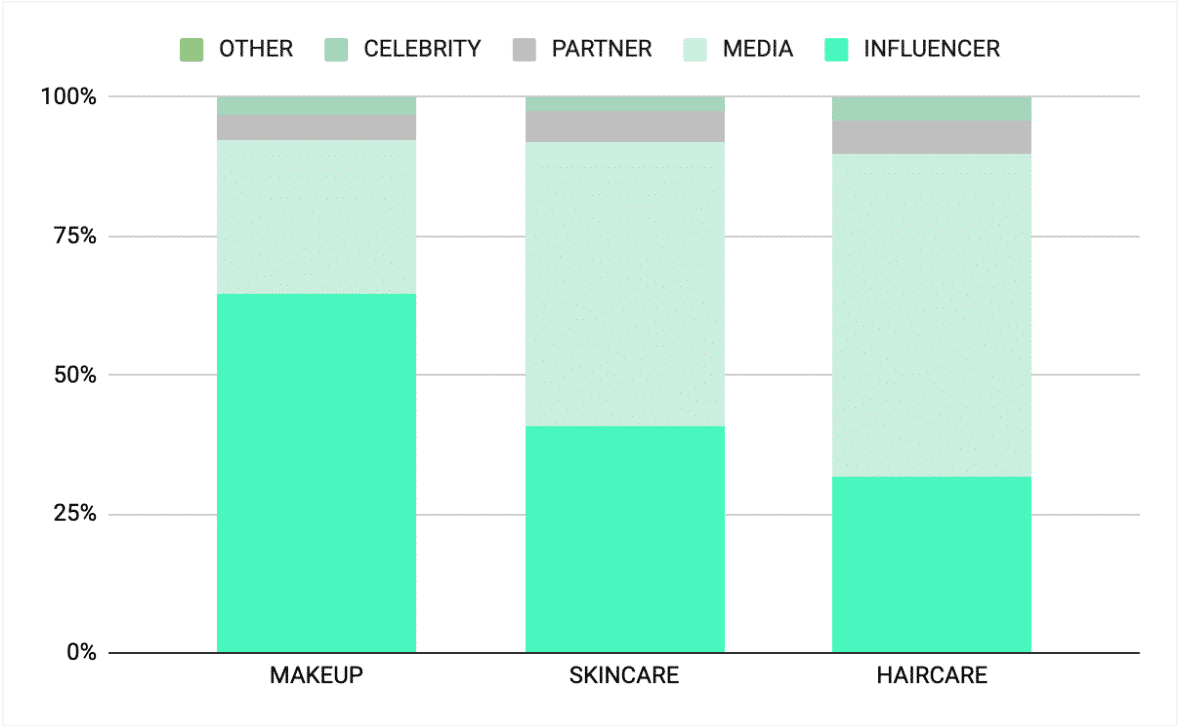
Understanding this Voice-mix benchmark is paramount in capitalizing on opportunities and crafting impactful marketing strategies. By delving into the most influential Voices for each skincare products’ messages – be it Media, Influencers, Celebrities, Partners, or Other – brands can unlock substantial enhancements within the skincare category.
10 Beauty Brands Dominating Skincare Coverage by MIV®
The infographic below displays the ranking of the ten beauty brands in Q1 2023 with a focus on skincare.
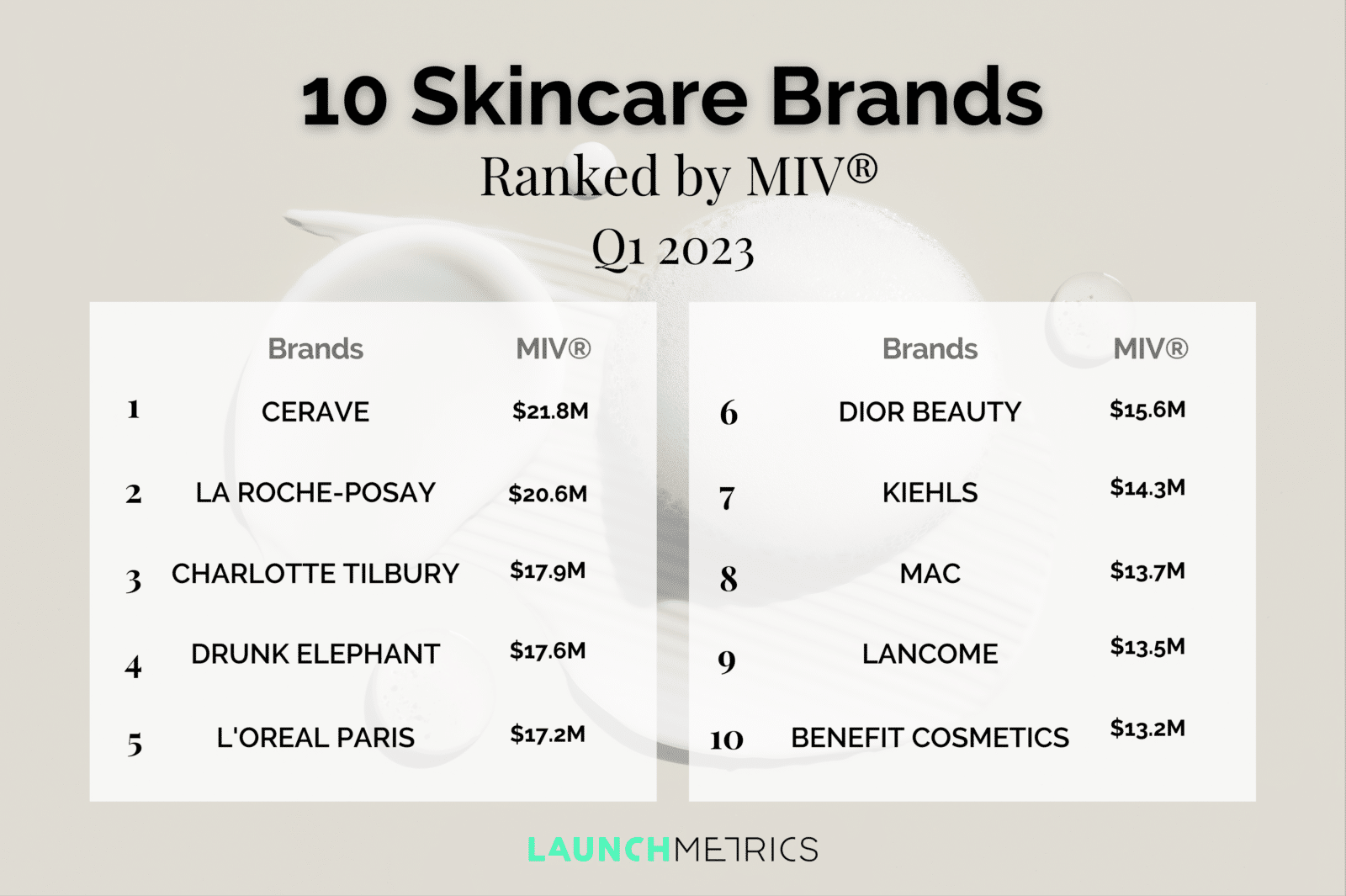
We used our proprietary algorithm, Media Impact Value™ (MIV®), to measure and benchmark the impact of all media placements and mentions across various Voices. These placements factor in social media posts and articles related to specific search queries, as well as consumer interactions with posts, such as tags and comments. It provides a snapshot of some brand’s performance in comparison to others in the industry. This allows brands to identify opportunities for growth and maximize your impact.
Subcategories in Skincare Coverage
In today’s beauty landscape, adopting a detailed approach to categorizing skincare products is not merely a luxury – but a prerequisite for brands to thrive. McKinsey’s research reveals substantial growth potential in various beauty sectors. The definition of beauty has expanded beyond traditional boundaries. Now, brands must have full visibility on the key subcategories within skincare coverage to effectively capitalize on emerging trends and consumer preferences. Without awareness of your product’s position within the competitive landscape, sustainable growth becomes elusive. Consequently, it is crucial to define your campaign approach locally and globally to make a significant impact within your desired category.
According to a report by Research Dive, the global skincare market is projected to experience a compound annual growth rate of 6.7% from 2022 to 2031. Several factors contribute to this growth, including increased heightened skincare awareness, and the availability of diverse products catering to different skin types and concerns. Understanding the most popular trends and preferences at specific times and locations becomes paramount.
The Key Subcategories in Skincare Coverage
While the fashion industry suffered during the pandemic, beauty products remained resilient due to the prevailing “self-care” trend. Consequently, brands are exploring new categories and approaches to overcome pandemic-induced financial challenges and reach untapped consumer segments. The convergence of wellness and beauty presents a transformative opportunity for brands. By delving deeper into product categorization, tailoring offerings to align with the evolving demands of health-conscious consumers, and leveraging modern digital tools, brands can identify their biggest opportunities.
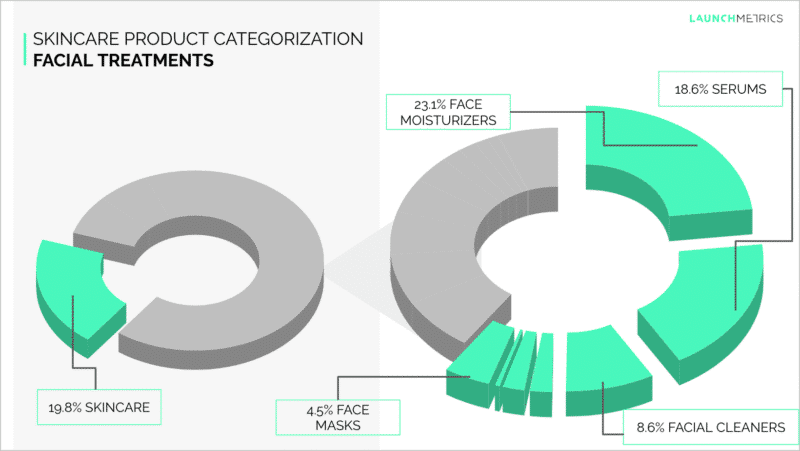
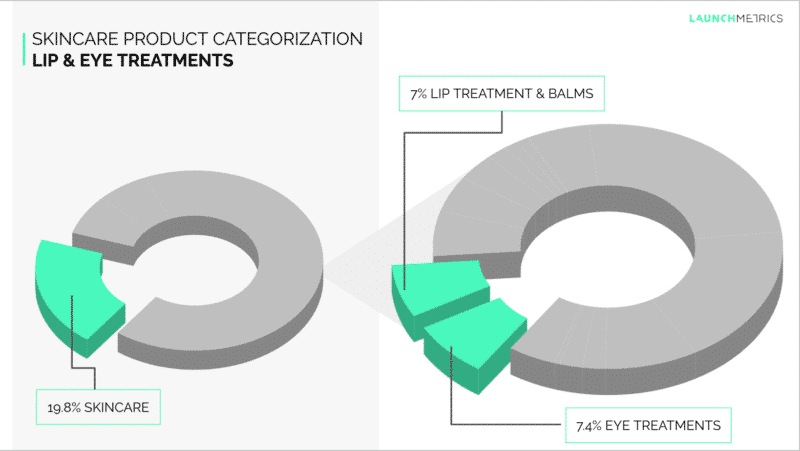
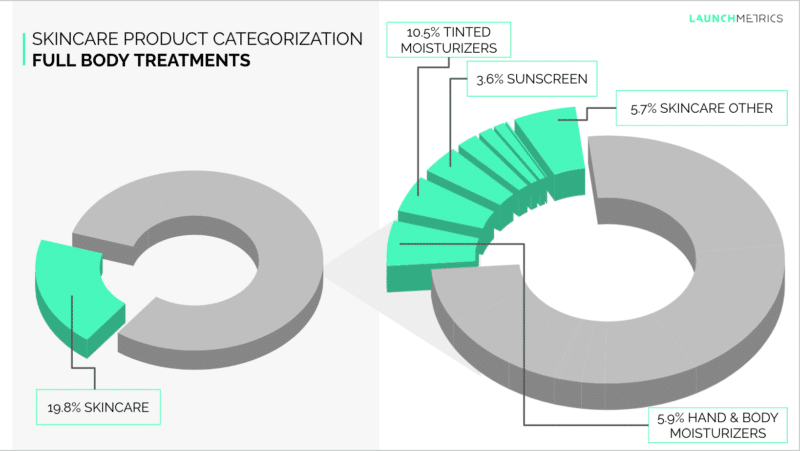
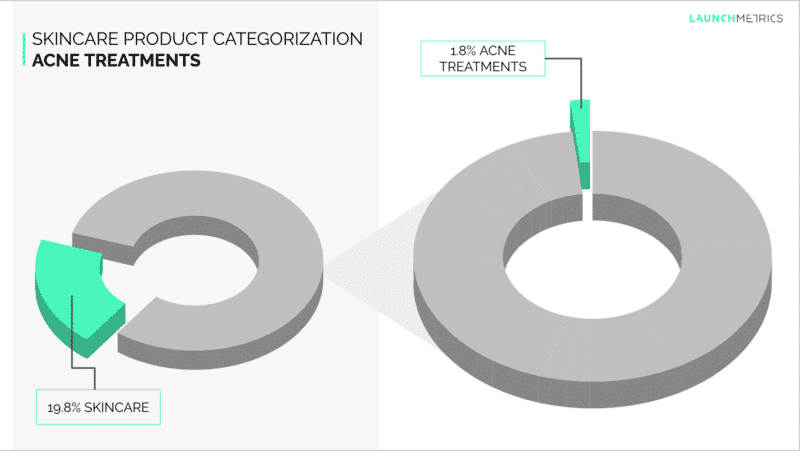
These valuable beauty insights enable the better definition of a value proposition for new markets, allowing teams to devise targeted strategies for success overseas. Identifying areas with the highest growth potential enables brands to execute their strategies effectively.
By establishing themselves as experts in these nuanced subcategories, brands position themselves as industry leaders and capture the loyalty of consumers embracing the wellness-driven approach to beauty. In this exciting era of beauty and wellness convergence, harnessing the power of granular performance data becomes essential for navigating the extensive world of beauty. With up to 54 industry subcategories at your disposal, ranging from serums and moisturizers to sunscreen, gaining invaluable beauty insights into your brand’s performance within each category becomes possible.
This knowledge allows you to identify untapped opportunities within your most successful product lines, allocate your marketing budget strategically, and benchmark your brand against competitors, ultimately driving growth.
Equip yourself with the knowledge necessary to make informed decisions, seize growth opportunities and establish your brand as a force to be reckoned with. By understanding your product’s position within the industry and leveraging this knowledge to drive strategic actions, you can ignite your brand’s success and make a resounding impact in your targeted space.
Performing Brands by Subcategories (MIV®)
In our quest to understand the power of skincare subcategories, we delved into brand performance across various categories like moisturizers, cleansers, serums, and acne treatments. As we analyzed the rankings, a fascinating pattern emerged. While certain brands consistently dominated the top ten in specific product categories— Cerave, Charlotte Tilbury, La Roche-Posay, and Mac—their coverage was not always as strong across other different product lines.
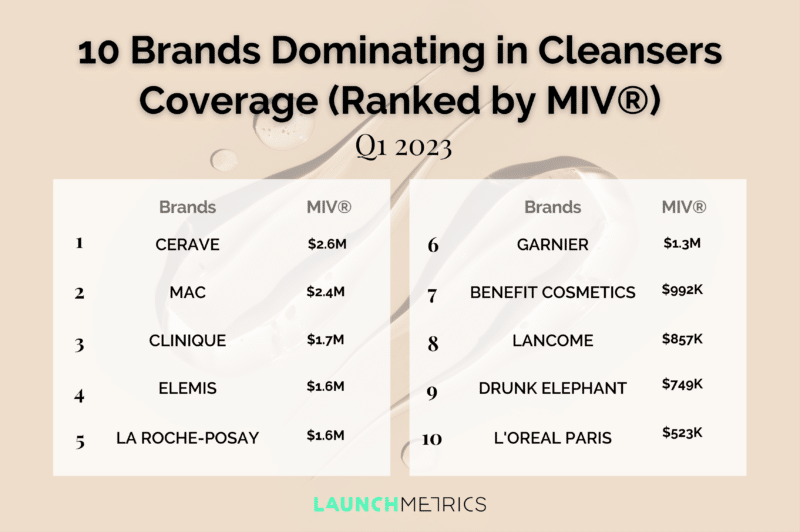
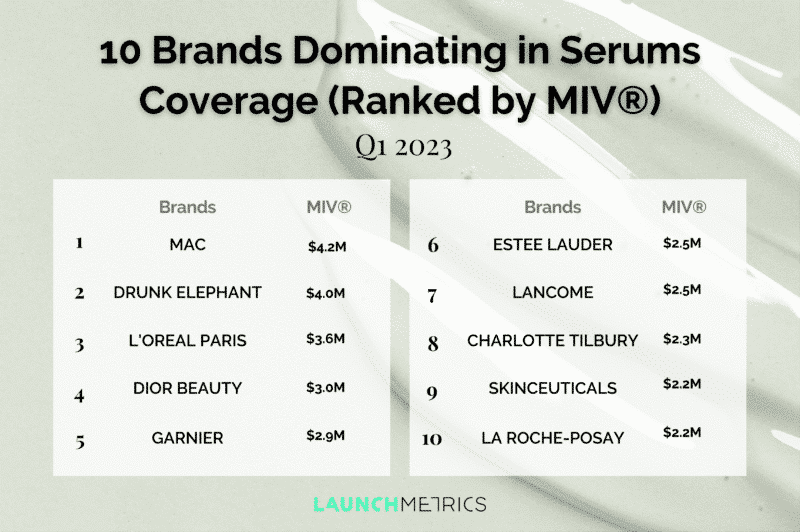
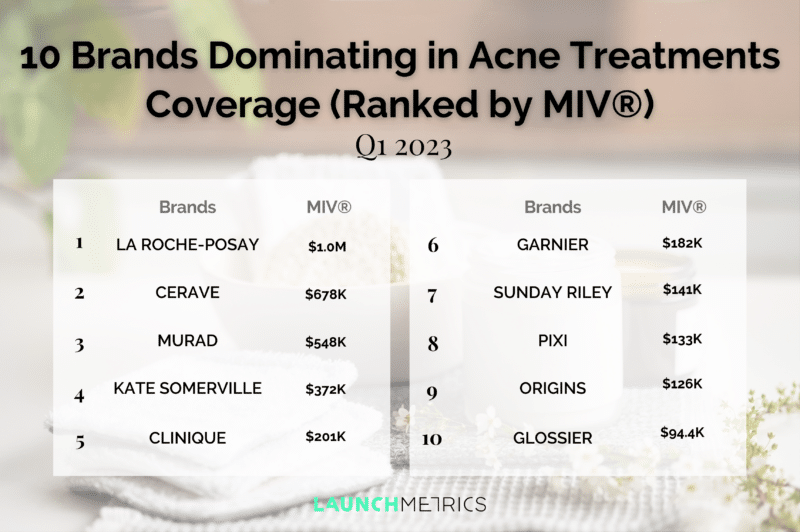
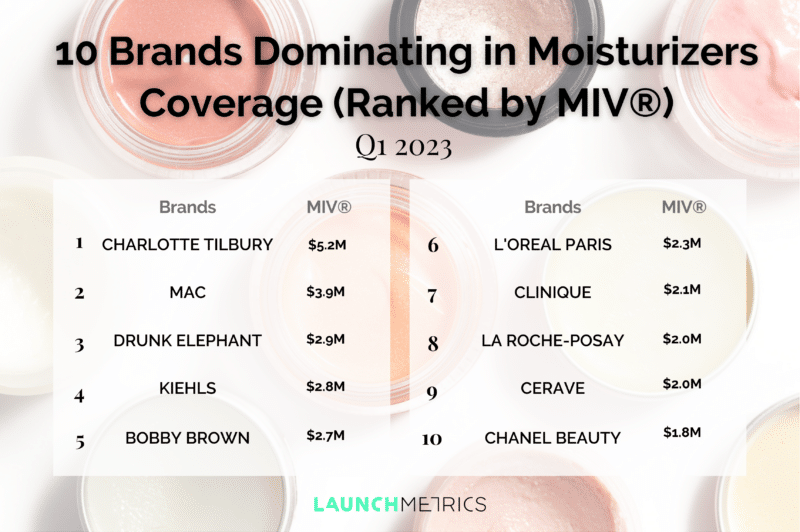
This discovery highlights a critical need for skincare brands. They need to have visibility on the key subcategories gaining coverage online, on social media, and in print. To unlock the full potential of your brand, it’s essential to grasp how each subcategory performs. You should strategically position your brand for success.
You can enhance your brand’s performance and capture the attention of your target audience. To do so, you should start by uncovering the gaps in your coverage and identifying areas for improvement.
Gain better understanding of your brand’s true potential, it’s crucial to explore the intricacies of each subcategory and align your marketing efforts accordingly.
Top Placements by Subcategories (MIV®)
Let’s take a closer look at some notable placements we discovered for this beauty insights blog. In the realm of Instagram, a single post by the esteemed American actress, Dylan Mulvaney, promoting Milk Makeup’s skincare “other” category, generated an astonishing $1.1M in MIV®.
Moving on to the facial hair grooming trend. An Instagram post by the renowned Spanish actor, Manu Rios, featuring Yves Saint Laurent Beauty, resulted in an impressive $717K in MIV® for the brand. And when it comes to serums, a placement by Influencer-Voice Emma Chamberlain showcasing Lancôme in the US topped the charts with $540K in MIV®. While another placement by Influencer-Voice Afra Saraçoğlu for Garnier, a Turkish actress, garnered $467K in MIV®.
But let’s not underestimate the impact of other channels. Dipika Ki Duniya, an influential Indian vlogger, featured a Garnier serum in one of her YouTube videos. Her video accumulated a remarkable $431K in MIV® for the brand. And on TikTok, American Influencer Mikayla Mogueira’s short video propelled Dior Beauty’s lip balm to a staggering $375K in MIV®. As Mikayla’s loyal followers seek her advice and recommendations, she becomes a powerful advocate for brands in the makeup category.
In this complex beauty landscape, aligning your brand with the right Voices is paramount. Whether it’s through collaborations with celebrities or influential social media personalities, these partnerships play a pivotal role in driving your brand’s performance and propelling growth.
Don’t miss out on the opportunity to increase your brand’s visibility and captivate your audience. Embrace the power of skincare subcategories. Leverage the influence of Voices and position your brand for unparalleled success in the ever-evolving beauty industry.
Beauty Insights│Maximizing Your Beauty Brand’s Impact
In today’s fiercely competitive beauty industry, staying ahead of the curve is essential for success. Through our dynamic beauty insights capsule series, we continuously look at the transformative potential of beauty categorization. As we conclude this second installment, we invite you to deep dive into your brand’s individual product performances. Doing so, you’ll be able to better understand your brand’s standing and make informed decisions to establish a lasting impact.
By embracing the power of skincare subcategories, you’ll gain a profound understanding of your brand’s overall performance. Navigate the extensive beauty landscape and identify emerging opportunities. Through strategic actions and a deep understanding of your product’s standing, you’ll ignite your brand’s success. It’s now or never to make a resounding impact in your targeted space.
